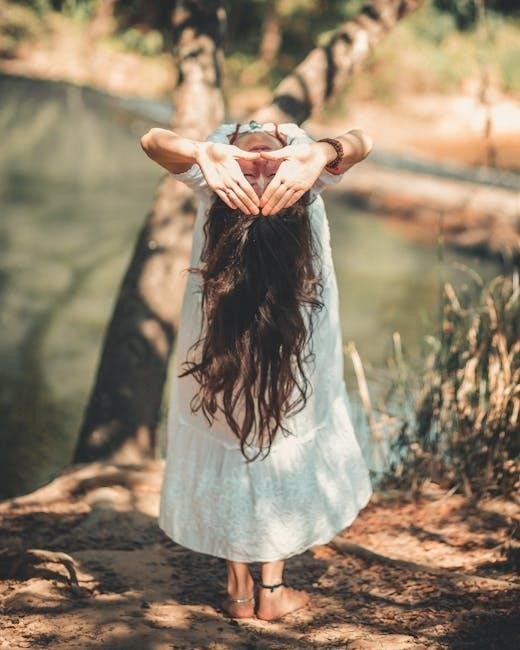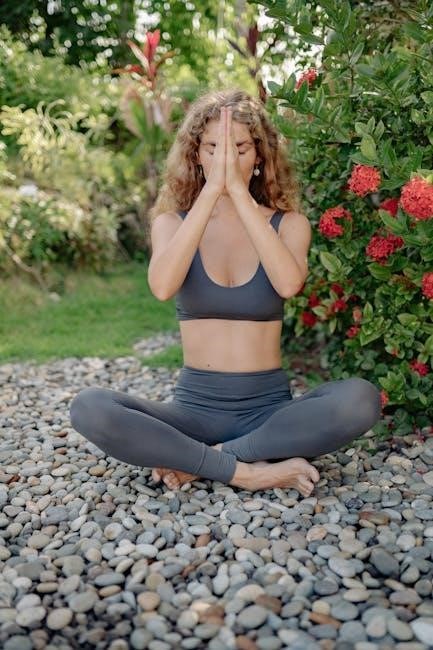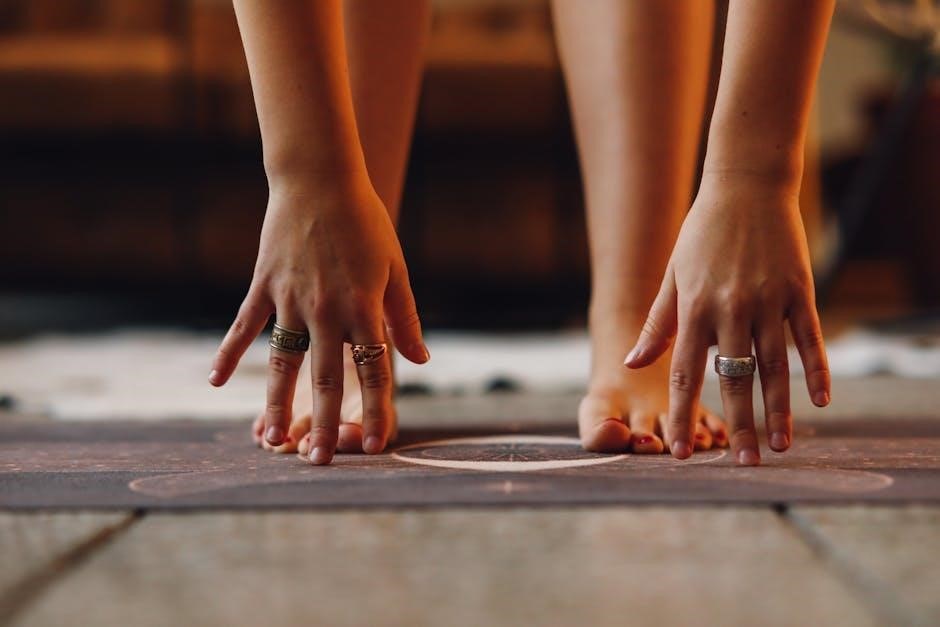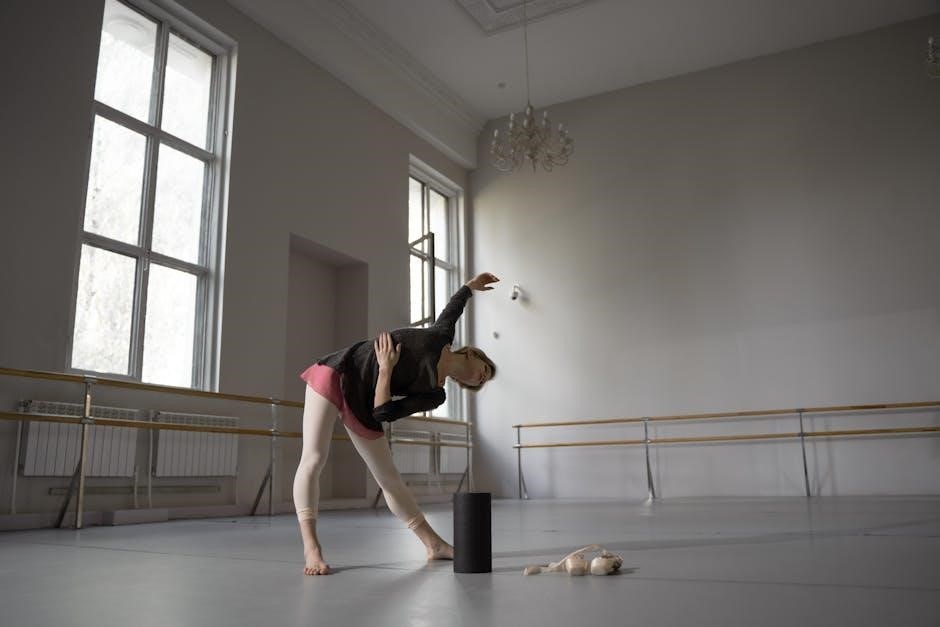Yoga flow sequences are structured series of poses linking breath with movement, enhancing flexibility, strength, and mindfulness. A yoga flow sequence PDF provides a guide for practices, from warm-ups to relaxation, perfect for home or class use, promoting balance and inner peace through intentional flows.
What is a Yoga Flow Sequence?
A yoga flow sequence is a thoughtfully designed series of poses linked by breath and movement, creating a harmonious practice. These sequences, often available as downloadable PDFs, guide practitioners through structured flows that enhance flexibility, strength, and mindfulness. They cater to various styles, such as Vinyasa, Hatha, or Yin yoga, and may focus on specific goals like stress relief or energy renewal. Whether for home practice or classroom instruction, a well-structured yoga flow sequence promotes balance, inner peace, and a deeper connection to the body and mind. They are adaptable to all levels, ensuring a transformative experience for everyone.
Why Use a Yoga Flow Sequence PDF?
A yoga flow sequence PDF offers a convenient and accessible way to plan and follow structured practices. It provides clear, visual guidance, making it easier to understand transitions and poses. PDFs are portable, allowing you to practice anywhere without needing internet access. They also serve as a valuable reference, helping you stay consistent and track progress. Many PDFs are modifiable, enabling customization to suit individual needs or goals. Using a PDF enhances organization and ensures a balanced practice, making it an essential tool for both beginners and experienced practitioners seeking to deepen their yoga journey.
Types of Yoga Flow Sequences
Yoga flow sequences vary widely, catering to different goals and styles. They range from dynamic Vinyasa flows to gentle Hatha, restorative, and Yin practices, each offering unique benefits.
Vinyasa Flow Sequences
Vinyasa Flow sequences are dynamic and flowing, linking breath with movement to create a meditative practice. They often feature Sun Salutations, warrior poses, and balancing postures, designed to build strength and flexibility. These sequences emphasize fluid transitions, fostering internal heat and detoxification. Ideal for those seeking a vigorous yet mindful practice, Vinyasa flows improve cardiovascular health and mental clarity. They are highly adaptable, allowing modifications for all levels. A Vinyasa Flow sequence PDF provides structured guidance, helping practitioners maintain rhythm and focus, ensuring a balanced and transformative experience.

Hatha Yoga Sequences
Hatha Yoga sequences focus on classical postures and breathing techniques to balance the body’s energy. These sequences are structured to build strength, flexibility, and mental clarity. They often include foundational poses like Mountain, Downward Dog, and Warrior, held for extended periods to deepen the practice. Hatha sequences are ideal for beginners or those seeking a steady, meditative flow. A Hatha Yoga sequence PDF provides clear guidance, ensuring proper alignment and modifications. It emphasizes a calm, deliberate pace, making it perfect for those looking to establish a strong yoga foundation and cultivate inner peace.
Yin Yoga Flow Sequences
Yin Yoga flow sequences emphasize deep stretching and relaxation, targeting connective tissues and joints. These sequences often involve passive, floor-based postures held for extended periods to promote flexibility and inner calm. Yin flows focus on releasing tension and improving circulation, making them ideal for stress relief and deep relaxation. A Yin Yoga sequence PDF typically includes detailed pose descriptions, timing, and modifications, guiding practitioners through meditative flows that enhance mindfulness. This practice is perfect for balancing active lifestyles and fostering emotional well-being through its slow, intentional movements.
Restorative Yoga Sequences
Restorative Yoga sequences focus on deep relaxation and rejuvenation, using props like bolsters and blankets to support the body in passive poses. These sequences often involve holding poses for extended periods, typically 5 to 20 minutes, to allow the body to release tension and promote healing. The goal is to activate the parasympathetic nervous system, fostering calm and reducing stress. A Restorative Yoga sequence PDF provides detailed guidance on pose setup, duration, and modifications, making it easy to create practices that enhance well-being and support recovery.

Benefits of Using a Yoga Flow Sequence PDF
Using a Yoga Flow Sequence PDF offers structured guidance, enhancing practice consistency and portability. It provides clear instructions for poses, breathing, and transitions, promoting a balanced and effective yoga routine.
Improved Flexibility and Strength
A Yoga Flow Sequence PDF enhances flexibility by guiding you through dynamic stretches and poses that target major muscle groups. Regular practice strengthens muscles, improving posture and overall physical stability. The structured sequences ensure balanced development, preventing overuse injuries. By incorporating both static holds and flowing movements, the PDF helps increase range of motion while building endurance. Over time, consistent practice leads to noticeable improvements in flexibility and strength, making daily activities easier and promoting long-term physical well-being.
Enhanced Mindfulness and Focus
A Yoga Flow Sequence PDF fosters mindfulness by guiding you to synchronize breath with movement, creating a meditative flow. The structured sequences help train the mind to stay present, reducing mental distractions. As you progress through poses, focus improves, enhancing your ability to concentrate. Regular practice cultivates a sense of calm and clarity, translating to better mental discipline in daily life. By emphasizing intentional transitions and awareness, the PDF helps you develop a stronger connection between body and mind, leading to improved focus and emotional balance.
Stress Relief and Relaxation
A Yoga Flow Sequence PDF is an excellent tool for stress relief, as it combines physical postures, breathing techniques, and mindful movement to calm the mind and body. The structured flows help release tension, promoting deep relaxation and reducing anxiety. By incorporating poses like forward bends, twists, and restorative postures, the sequences target areas where stress is commonly held. Controlled breathing practices, such as ujjayi and alternate nostril breathing, further enhance relaxation by balancing the nervous system. Regular practice fosters emotional resilience, helping you manage stress more effectively and maintain a sense of calm in daily life.
How to Structure a Yoga Flow Practice
A well-structured yoga flow practice begins with a warm-up, progresses to peak poses, and ends with a cool-down, ensuring a balanced and safe experience.
Warm-Up and Breathing Techniques
A yoga flow practice begins with a warm-up to prepare the body for movement. Gentle stretches, neck rolls, and shoulder openers are common. Incorporate breathing exercises like ujjayi (ocean breath) or nadi shodhana (alternate nostril breathing) to center the mind and balance energy. These techniques enhance oxygen flow, calm the nervous system, and set an intentional tone for the practice. Transition smoothly into foundational poses, ensuring a gradual increase in intensity. Proper warm-up and breathing lay the groundwork for a safe, focused, and transformative yoga flow sequence. Always prioritize breath awareness to maintain harmony between movement and relaxation.
Peak Poses and Transitions
Peak poses are the highlight of a yoga flow sequence, representing the most challenging or climactic postures. Properly transitioning into these poses ensures a smooth and injury-free practice. Use dynamic movements and breath synchronization to build momentum. For example, moving from plank to chaturanga or flowing into wheel pose requires controlled breathing and alignment. Transitions should be intentional, linking poses logically to maintain the flow’s rhythm. Design sequences that gradually prepare the body for peak poses, using intermediate postures to build strength and flexibility. This approach enhances the practice’s effectiveness and creates a cohesive, transformative experience for all levels. Always emphasize safe transitions to honor the body’s capabilities and promote longevity in practice.
Cool-Down and Relaxation
The cool-down phase in a yoga flow sequence is essential for gradually slowing the body and mind. It involves gentle stretches, calming postures, and deep breathing to release tension. Poses like child’s pose, seated forward fold, or legs-up-the-wall help lower the heart rate and promote relaxation. Incorporate mindfulness techniques, such as guided meditation or mantra chanting, to deepen the calming effect. This phase also prepares the body for savasana (corpse pose), the final relaxation. Always prioritize slow, intentional movements to allow the body to transition smoothly into a restorative state, enhancing the overall benefits of the practice.

Popular Yoga Flow Sequences for Download
Discover diverse yoga flow sequences, from dynamic core workouts to gentle hip-opening flows, designed for all levels and goals, available as easy-to-follow PDF downloads.
60-Minute Core Yoga Sequence
A 60-minute core yoga sequence is designed to strengthen the core muscles, improve balance, and enhance overall stability. This dynamic flow typically begins with a warm-up, incorporating foundational poses like Mountain Pose and Sun Salutations to prepare the body. The sequence progresses to standing poses such as Warrior II and Triangle Pose, which build strength and focus. Peak poses, including Boat Pose and Plank variations, target the deep abdominal muscles. Transitions are smooth, with a focus on breath synchronization. The practice concludes with cooling stretches to release tension and promote relaxation, leaving practitioners feeling centered and energized.
Hip Opening Yoga Flow Sequence
A hip-opening yoga flow sequence focuses on releasing tension in the hips and lower back, improving flexibility and range of motion. This sequence often begins with gentle warm-up poses like Cat-Cow and Downward Dog to prepare the body. Foundational hip-opening poses such as Pigeon Pose, Seated Forward Fold, and Bound Angle Pose are incorporated to target the hip joints and surrounding muscles. Balancing poses like Tree Pose and Warrior II help maintain stability and alignment. The flow may include twists and deep stretches to enhance release. Props like blocks and cushions are often used for support, ensuring a safe and effective practice.
Slow Flow Yoga for Energy Renewal
A slow flow yoga sequence is designed to renew energy and balance the body’s vitality. It combines deliberate, meditative movements with synchronized breathing to foster relaxation and inner calm. The sequence often begins with gentle stretches and foundational poses like Child’s Pose or Seated Forward Fold. Standing poses, such as Triangle Pose, are incorporated to build subtle energy and openness. Smooth transitions between poses, like Cat-Cow or Half Moon Pose, maintain a flowing rhythm without exertion. Conscious breathing techniques enhance the practice, while restorative poses at the end seal in renewal. Props like bolsters or blankets support deep relaxation, making this sequence ideal for rejuvenation.

Customizing Your Yoga Flow Sequence

Customizing your yoga flow sequence allows you to tailor poses, breathwork, and timing to suit your goals, level, and energy. It enhances personal alignment and growth.
Modifying Poses for Different Levels
Modifying poses ensures accessibility and safety for practitioners of all levels. Beginners can use props like blocks or straps to simplify poses, while advanced students can deepen stretches or add complex variations. Instructors often offer alternatives to cater to different abilities, promoting inclusivity and preventing injuries. This approach allows each individual to engage meaningfully with the practice, fostering progress and confidence. By tailoring poses to meet diverse needs, yoga becomes adaptable and beneficial for everyone, regardless of their starting point or physical capabilities.
Creating a Sequence for Specific Goals
Designing a yoga flow sequence for specific goals involves aligning poses with intended outcomes, such as strength, flexibility, or relaxation. Start by identifying the primary objective, then select poses that target the relevant muscle groups or energy centers; Incorporate breathing techniques to enhance focus and alignment. For example, a sequence for stress relief might include gentle stretches and calming postures like child’s pose or pigeon pose. Tailor transitions to maintain a balanced flow, ensuring each pose logically progresses toward the desired goal. This intentional structure maximizes the practice’s effectiveness and ensures a meaningful experience.

Using Props in Yoga Flow Sequences
Props in yoga flow sequences are tools to enhance your practice by improving alignment, reducing injury risk, and providing comfort. They support modifications and ensure accessibility for all levels, allowing everyone to benefit fully;
Blocks, Cushions, and Straps
Blocks, cushions, and straps are essential props in yoga flow sequences to enhance accessibility and comfort. Yoga blocks, made of foam, wood, or cork, help reach the ground in standing poses and support hands or foreheads. Cushions or bolsters provide support for seated postures, forward bends, or restorative poses, promoting relaxation. Straps assist in deepening stretches or maintaining proper alignment, especially in poses like Seated Forward Bend or Hanumanasana. These props allow practitioners to modify poses according to their flexibility and strength levels, ensuring a safe and effective practice. They are particularly useful for beginners or those with physical limitations, making yoga inclusive for all.

How to Incorporate Props into Your Flow
Incorporating props into your yoga flow sequence enhances accessibility and alignment. Start by assessing your practice and identifying poses where support is needed. Place blocks strategically under hands, forearms, or hips to maintain proper alignment. Use cushions or bolsters to support seated or restorative postures, promoting relaxation. Straps can deepen stretches or assist in maintaining poses like Tree or Seated Forward Bend. Adjust props as needed throughout the sequence to ensure comfort and stability. This mindful use of props allows for a smoother, more sustainable flow, catering to individual needs and enhancing the overall practice experience.
The Science Behind Yoga Flow Sequencing

Yoga flow sequencing combines movement patterns with breath synchronization, optimizing energy flow and physiological responses. It aligns with the body’s natural rhythms, enhancing strength, flexibility, and mental clarity through intentional transitions and pose arrangements.
The Importance of Breath and Movement Synchronization
Breath and movement synchronization are foundational to yoga flow sequences, creating a harmonious connection between the body and mind. This synchronization enhances physical postures, balance, and endurance while calming the nervous system. Coordinating breath with movement ensures efficient energy flow, improving circulation and oxygenation of tissues. It also deepens mental focus, fostering a meditative state. Proper alignment of breath and movement prevents injury, making practices safer and more effective. This synergy is key to unlocking the full potential of yoga, promoting holistic well-being and spiritual growth through mindful, intentional practice.
Understanding the Arc of a Vinyasa Flow Class
A Vinyasa Flow class follows a dynamic arc, beginning with gentle warm-ups to prepare the body and mind. It builds intensity with flowing sequences, linking postures through breath and movement. The class peaks with challenging poses, fostering strength and flexibility, before gradually cooling down with restorative stretches and relaxation. This structured progression ensures a balanced practice, enhancing physical and mental well-being. Understanding this arc helps practitioners appreciate the flow’s logic and benefits, making their yoga journey more intentional and transformative. A yoga flow sequence PDF can guide this process, providing clear pathways for an effective Vinyasa practice.

Resources for Downloading Yoga Flow Sequences
Discover a variety of platforms offering yoga flow sequence PDFs. Websites like Yoga International and DoYouYoga provide downloadable sequences, while social media groups and forums share community-created flows.
- Explore free resources on yoga websites.
- Join online yoga communities for shared sequences.
- Check out paid platforms for premium content.
Where to Find Free Yoga Flow PDFs
Accessing free yoga flow PDFs is straightforward with various online resources. Many yoga studios offer complimentary sequences on their websites to attract practitioners. Educational yoga websites like Yoga International and Doyouyoga provide downloadable PDFs for different levels and goals. Social media platforms, such as Instagram and Facebook, often feature instructors sharing free sequences. Additionally, online forums and yoga communities frequently share user-created flows. These resources cater to both beginners and advanced practitioners, ensuring everyone can benefit from structured yoga practices without cost.
- Visit yoga studio websites for free downloads.
- Explore educational yoga platforms for diverse sequences.
- Engage with social media for instructor-shared content.
- Join forums for community-created flows.
Recommended Websites for Yoga Sequence Downloads
Discover top websites offering high-quality yoga flow sequence PDFs. Yoga International and DoYouYoga provide extensive libraries of downloadable sequences for all levels. Tummee and YogaDownload also offer diverse flows tailored to specific goals like flexibility or stress relief. These platforms often include customizable templates and class planning tools. Whether you’re a teacher or a practitioner, these sites cater to your needs with well-structured and accessible sequences. Explore these resources to enhance your practice or teaching with ease and variety.
- Yoga International: Extensive library of sequences.
- DoYouYoga: Tailored flows for specific goals.
- Tummee: Customizable templates and tools.
- YogaDownload: Diverse flows for all levels.
